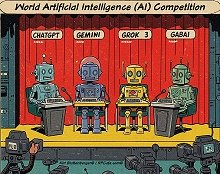Electronics & Technology
- See Full List of AI Topics -
 Thomas Edison, the renowned American inventor, did conduct some experiments related
to x-rays during his career. However, it's important to note that his contributions
to x-ray technology were relatively limited compared to other inventors and scientists
of his time. Thomas Edison, the renowned American inventor, did conduct some experiments related
to x-rays during his career. However, it's important to note that his contributions
to x-ray technology were relatively limited compared to other inventors and scientists
of his time.
In the late 19th and early 20th centuries, shortly after Wilhelm Conrad Roentgen
discovered x-rays in 1895, there was significant interest in understanding and utilizing
this new form of radiation. Edison, being a prolific inventor and entrepreneur,
recognized the potential applications of x-rays and decided to explore the field.
Edison's primary focus was on developing x-ray imaging devices and techniques,
rather than fundamental research into the properties of x-rays themselves. He saw
potential applications for x-rays in medical diagnostics and industrial testing.
In 1896, Edison established the Edison Manufacturing Company's x-ray department,
where he employed a team of researchers to work on x-ray-related projects. They
aimed to improve upon the existing x-ray equipment and develop more practical and
efficient x-ray imaging systems.
Edison's team experimented with various x-ray tube designs and explored methods
to enhance the quality and resolution of x-ray images. They also worked on improving
the reliability and safety of x-ray equipment. Some of their innovations included
the development of fluoroscopic screens for visualizing x-ray images in real-time
and the creation of x-ray tubes with improved vacuum systems.
While Edison's contributions to x-ray technology were notable, he faced challenges
in terms of competing with other inventors and scientists who were also making significant
advancements in the field. One such example is Nikola Tesla, who made important
contributions to x-ray technology, particularly in the development of more efficient
x-ray generators.
In the end, Edison's involvement in x-ray experimentation was relatively short-lived.
Due to the rising concerns about the health risks associated with x-ray exposure
and the subsequent regulatory measures, Edison gradually shifted his focus to other
projects. By the early 20th century, his interest in x-rays diminished, and he did
not make substantial contributions to the field beyond that point.
It's worth mentioning that while Edison's contributions to x-ray technology were
not as groundbreaking as some of his other inventions, his work helped pave the
way for further advancements in medical imaging and industrial applications of x-rays.
 This content was generated by primarily
the ChatGPT (OpenAI), and/or
Gemini (Google), and/or
Arya (GabAI), and/or
Grok (x.AI), and/or DeepSeek artificial intelligence (AI) engine.
Some review was performed to help detect and correct any inaccuracies; however,
you are encouraged to verify the information yourself if it will be used for critical
applications. In some cases, multiple solicitations to the AI engine(s) was(were) used to assimilate
final content. Images and external hyperlinks have also been added occasionally.
Courts have ruled that AI-generated content is not subject to copyright restrictions,
but since I modify them, everything here is protected by RF Cafe copyright. Many
of the images are likewise generated and modified. Your use of this data implies
an agreement to hold totally harmless Kirt Blattenberger, RF Cafe, and any and all
of its assigns. Thank you. Here are the major categories. This content was generated by primarily
the ChatGPT (OpenAI), and/or
Gemini (Google), and/or
Arya (GabAI), and/or
Grok (x.AI), and/or DeepSeek artificial intelligence (AI) engine.
Some review was performed to help detect and correct any inaccuracies; however,
you are encouraged to verify the information yourself if it will be used for critical
applications. In some cases, multiple solicitations to the AI engine(s) was(were) used to assimilate
final content. Images and external hyperlinks have also been added occasionally.
Courts have ruled that AI-generated content is not subject to copyright restrictions,
but since I modify them, everything here is protected by RF Cafe copyright. Many
of the images are likewise generated and modified. Your use of this data implies
an agreement to hold totally harmless Kirt Blattenberger, RF Cafe, and any and all
of its assigns. Thank you. Here are the major categories.
Electronics & High Tech
Companies | Electronics &
Tech Publications | Electronics &
Tech Pioneers | Electronics &
Tech Principles |
Tech Standards Groups &
Industry Associations | Societal
Influences on Technology
|







 Thomas Edison, the renowned American inventor, did conduct some experiments related
to x-rays during his career. However, it's important to note that his contributions
to x-ray technology were relatively limited compared to other inventors and scientists
of his time.
Thomas Edison, the renowned American inventor, did conduct some experiments related
to x-rays during his career. However, it's important to note that his contributions
to x-ray technology were relatively limited compared to other inventors and scientists
of his time. 
